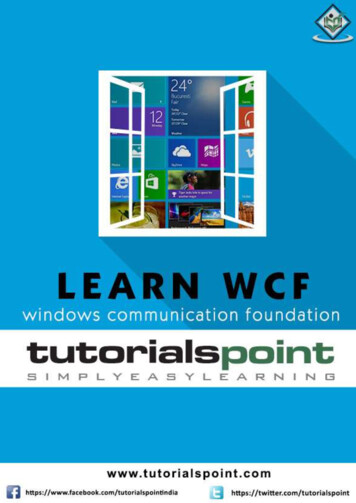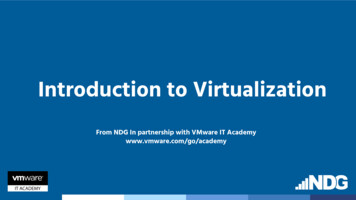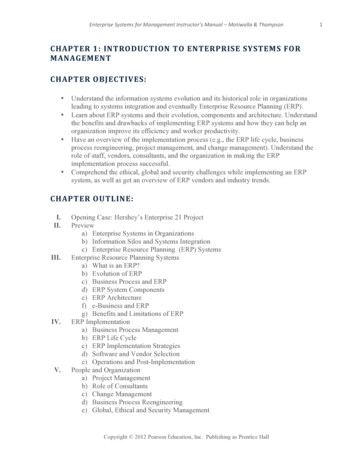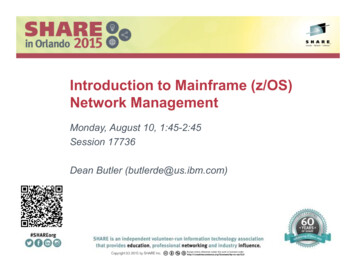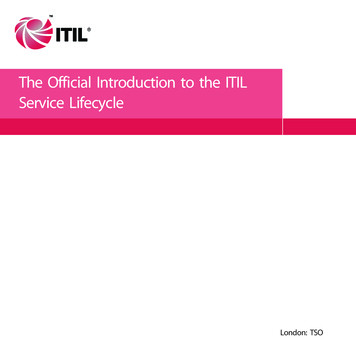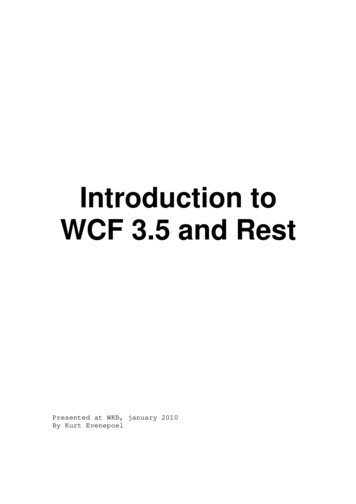
Transcription
Introduction toWCF 3.5 and RestPresented at WKB, january 2010By Kurt Evenepoel
Introduction to WCF 3.5 and Rest . 1What do you need . 3WCF Fundamentals . 3REST Fundamentals . 6Endpoints ‘R Us . 6Exploring Your Hosting Options . 10Creating a new Service Library . 11Defining and Implementing a Contract . 11Defining Endpoints . 12The Test Client . 14Consuming the service . 14SvcUtil.exe. 14Add Service Reference. 14Hosting the service from console . 16Transforming the service into a REST web service . 18Returning files or large amounts of data . 22Returning a feed . 23Debugging WCF . 24Accepting data . 28Sending JSON with C# . 31Further reading . 33Glossary (from MSDN) . 34
What do you need Visual Studio 2008 SP1.NET 3.5 SP1Windows SDK (was included in my installation: check ifyou have C:\Program or.exe)Both Visual Studio and .NET need to have SP1, not only.NET.WCF FundamentalsSince .NET 3.0 (Codename .NET FX) Microsoft has added lotsof new libraries to the .NET framework. One of these isWCF. WCF is expanded with Restful features in .NET 3.5 (C#3.0), and integrated with Workflow Foundation and othertechnologies. Many new .NET 3.5 technologies use WCF astheir underlying basis too. In .NET 4.0, WCF gets moreimportant, and in the future years to come WCF will replaceall microsoft distributed development technologies.Windows Communication Foundation (WCF) is all aboutcommunicating. In a stand-alone application like say XMLSpy, or Notepad you would not generally use services.In a business context, many dollars go into creatingsystems that support the business. It’s generally acceptedthat in such scenario’s, you do not want to tie a functionto a specific application. All applications, should theyneed that specific function, should be able to re-use it.You can do this by distributing a dll with the application,but then you also need update scripts when a new version isreleased, and manage the users access rights within Windowsand the database, and people could try to run yourapplication with old DLLs. There are several disadvantagesto this scenario.Or you can expose the functionality as a service, where oneservice is a building block of functionality offered by acentral server or cluster of servers. This building block
or service can use other services, or dlls. What isimportant is that the functionality is centrally managedand exposed to possible clients.Some of the advantages are :- by separating groups of functions (like objects) intoservices, each group of functions can be hosted on anyserver on the network, including the same one, or onmultiple servers under load-balancing- easy to loose-couple services because generally proxyclasses are used, so you can get intellisense, but theimplementation itself runs on the serverSo what is WCF all about then? It’s about writingdistributed systems and services, and exposing thefunctionality without being dependant on the method ofcommunication, so that the method of communication can befreely chosen and changed.A WCF Service is a program that exposes a collection ofEndpoints. Each Endpoint is a portal for communicating withthe world. Communication is handled by WCF, the logic howto respond to the messages by the developer. This enablesthe developer to develop logic that is not dependant on theway it is communicated.Eg: TCP, Peer-to-Peer, SOAP, Rest, wether they areauthenticated or secured with certificates or not.A Client is a program that exchanges messages with one ormore Endpoints. A Client may also expose an Endpoint toreceive Messages from a Service in a duplex messageexchange pattern.A message exchange pattern is a pattern how the client andthe service exchange messages. There are a number ofmessage patterns. Rest uses normal HTTP, so that’s arequest-reply pattern: the browser or client requests thepage, and the HTTP server returns a reply.WCF supports other patterns like Datagram (fire-and-forget)and Duplex (two-way). Sessions are also supported.WCF is extensible: if a protocol is not supported yet, youcan inject your own logic almost everywhere in theframework to ensure minimal development costs for changesin protocol, transport method and the likes. This iscalled a Behaviour, more on that later.
Traditional WCF in .NET 3.0 did not know Restful features,these were added in .NET 3.5. These features include ajaxsupport, Atom and RSS feeds and more.This decision tree helps decide what (binding) technologyto use for your endpoints in a non-restful scenario (aRestful scenario would always use the same type of setupfor endpoints, as you will see n’t be overwhelmed by this diagram. You will find ituseful someday. When choosing a SOAP binding, be carefulwhat you choose, your choice has serious performanceimplications. Always pick the fastest technology thatsupports your goals. Prefer two fast, specific endpointsto one do-everything endpoint over WS- so make that TCPendpoint for .NET clients by all means.That said, WCF is one-on-one faster than any technology itreplaces, including remoting, ASMX and most of all, WSE2.0, where WCF is many times faster and results in the sameendresult.
For the full performance comparison aspxREST FundamentalsREST is a resource-oriented architecture. The focus lieson the data, not on actions. Content as we know it in WKBis a prime example of a resource.REST is opposed to SOAP. SOAP is a complex protocol forinteroperating, offering many layers of security,versioning and more, and therefore is bloating the messagesby a large amount. Usually SOAP runs over HTTP, but in WCFit can run over TCP or other connections too. SOAP bypassesa lot of HTTP semantics and implements them again as itsown. REST on the other hand is lightweight, simplerprotocol that follows the HTTP way of working, and all ofit semantics: a header value of GET to retrieve something,PUT or POST to save something, and DELETE to delete aresource. SOAP is more versatile, but very complex andslow. REST is a lot faster and offers a lot less, and islimited to HTTP.Endpoints ‘R Us
A Service Endpoint has an Address, a Binding, and a Contract. The ABC of Communication FoundationThe Endpoint's Address is a networkaddres or URI WHERE.The Endpoint's Contract specifieswhat the Endpoint communicates and isessentially a collection of messagesorganized in operations that havebasic Message Exchange Patterns(MEPs) such as one-way, duplex, andrequest/reply. Generally we use aninterface with attributes to define acontract WHAT.There are several types of contracts:Service contractsDescribes which operations the client can perform on theservice.- ServiceContractAttributeapplied to the interface.- OperationContractAttributeapplied to the interface methods you want to exposeData contractsDefines which custom data types are passed to and from theservice (high-level).- DataContractapplied to the class that holds the data- DataMemberapplied the the class' properties you want to exchange- OR –Message contractsInteract directly with SOAP messages (low-level). Usefulwhen there is an existing message format we have to complywith.Fault contracts
Defines how the service handles and propagates errors toits clients.The Endpoint's Binding specifies how the Endpointcommunicates with the world including things like transportprotocol (e.g., TCP, HTTP), encoding (e.g., text, binary),and security requirements (e.g., SSL, SOAP messagesecurity) HOW.A behavior is a class that implements a special interfacefor "plugging into" the execution process. This is yourprimary WCF extensibility and customization point ifsomething is not supported out of the box. TWEAKWHERE/WHAT/HOWThere are a few types of behaviours:Service Behaviour- Applies to the entire service runtime in an application- Implements IServiceBehavior.Contract Behaviour- Applies to the entire contract- Implements IContractBehavior.Operation Behaviour- Applies to the service operation (think: method call)- Implements IOperationBehavior.Endpoint Behaviour- Applies to the endpoints- Implements IEndpointBehaviorCreating behaviours is something you can try yourself afterthis session, or can request another session on. There are3 ways:Writing code- Implement the behaviour interface- Add your behaviour to the Behaviors collection of therelated Start the service host.Decorating with an attribute(not for Endpoint behaviours)- Implement the behaviour interface- Inherit from Attribute- Decorate the wanted class with your class.Configuration
(not for Contract or Operation behaviours)- Derive from BehaviorExtensionElement.(see spx)It’s important to note that behaviours are a server-sideonly thing: the WCF client classes make no use of them.In many projects behaviours won’t be needed, and all you’llneed is the ABC. It’s common however to need to tweakthings a little. This is where we add another B – ABBC.Almost ABBA but not quite.All of this may seem a bit daunting at first. Don’t worryabout the specifics too much yet. You need will need toknow more about them when you use SOAP. There is much toknow because WCF is so powerful. Simple scenario’s don’trequire you to know everything in-depth as you will see,and if you know some basics you will get your servicerunning in no time. For Rest scenario’s, knowing all thedetails is not needed to get you started, so we won’telaborate on them in this session.Now lets get started in practise.
Exploring Your Hosting OptionsOn the Microsoft .NET platform, you have several types ofmanaged Windows applications that you can create withMicrosoft Visual Studio.NET: WinForms applicationsConsole applicationsWindows servicesWeb applications (ASP.NET) hosted on InternetInformation Services (IIS)WCF services inside IIS 7.0 and WAS on Windows Vistaor Windows Server 2008WCF doesn't block you from running your service in anyother type of application as long as it provides you with a.NET application domain. It all comes down to therequirements you have for your host. To summarize theoptions, think about the following three generic categoriesof hosts for your WCF services: Self-hosting in any managed .NET applicationHosting in a Windows serviceHosting in different versions of IIS/ASP.NETWe will be self-hosting the service eventually in a consolewindow, creating your own webserver (sortof)!
Creating a new Service Library Create a new WCF Service Library. Delete both Service.cs and IService.csWhy did we start a Service Library only to toss everythingout? Some project types add entries to menus. Like inthis case, it will add the ability to visually edit theapp.config.Defining and Implementing a ContractThe easiest way to define a contract is creating aninterface or a class and annotating it withServiceContractAttribute.For example:using System.ServiceModel;//a WCF contract defined using an interface[ServiceContract]public interface IMath{[OperationContract]int Add(int x, int y);}
Then create a class that implements IMath. That classbecomes the WCF Service class.For example://the service class implements the interfacepublic class MathService : IMath{public int Add(int x, int y){ return x y; }}Defining EndpointsEndpoints can be defined in code or in config. We’ll beusing config. configuration system.serviceModel behaviors serviceBehaviors behavior name "mexSvcBehaviour" serviceMetadatahttpGetEnabled "false" httpsGetEnabled "false" / /behavior /serviceBehaviors /behaviors bindings / services service behaviorConfiguration "mexSvcBehaviour"name "WCFRest.MathService" endpointaddress "http://localhost:41000/MathService/Ep1"binding "wsHttpBinding"contract "WCFRest.IMath" / endpointaddress "http://localhost:41000/MathService/mex"binding "mexHttpBinding"bindingConfiguration ""contract "IMetadataExchange" / /service /services /system.serviceModel /configuration Generally config is preferred. In some project types youwill find the Edit WCF Configuration menu option by rightclicking on the App.config.
Using this editor you caneasily set the optionsneeded for your service. Ifnot present run cConfigEditor.exe on app.configfor the same editor.For now, just copy-paste theApp.config from above intoyours.
The Test ClientIf you run your service, you’ll see the test client isautomatically configured to run when you run the dll.Note: the test client is not useful for Rest-tests. If youstarted a SyndicationLibrary project, IE will be usedinstead of the WCF Test Client.Consuming the serviceThere are 2 ways to generate classesSvcUtil.exeC:\Program seful tool for generating classes based on WDSL.Add Service ReferenceLike Add Reference except the menu option just below
Add a new windows console project called WCFClient tothe solution.Add a service reference to the service in the solutionas shown above, use a namespace you’ll remember.Add a normal reference to System.ServiceModelIn static void main, do the following:internal class Program{/// summary /// Starts the application///
WCF Fundamentals Since .NET 3.0 (Codename .NET FX) Microsoft has added lots of new libraries to the .NET framework. One of these is WCF. WCF is expanded with Restful features in .NET 3.5 (C# 3.0), and integrated with Workflow Foundation and other technologies. Many new .NET 3.5 technologies use WCF as their underlying basis too. In .NET 4.0, WCF gets more
